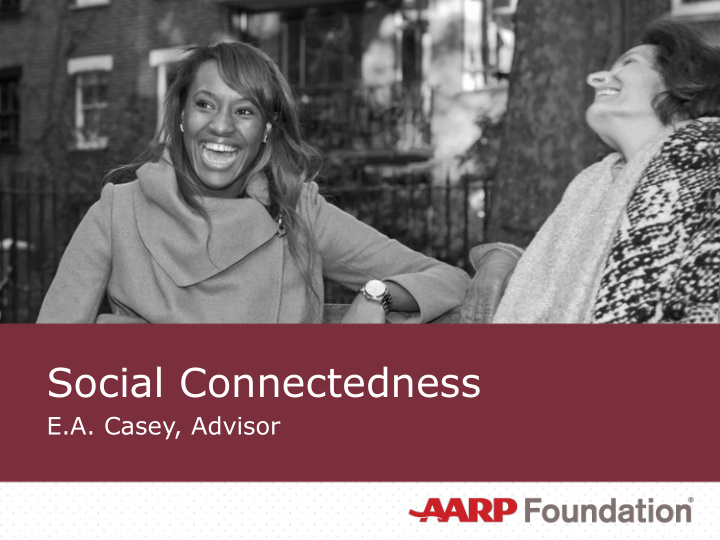



Social Connectedness E.A. Casey, Advisor
The Problem The Health Risks of Isolation and Loneliness High Blood Pressure Heart Disease Diabetes Weakened Immune system Sleep Problems Depression and Anxiety Alcohol & Pain Medication abuse Cognitive Decline, Dementia The list goes on… Isolated and lonely older adults have a higher risk of: Needing long-term care Increased ER visits Becoming a victim of fraud Becoming a victim of elder abuse Dying early Medicare spends more on MALNUTRITION isolated older adults: $1608 per person each year Totaling $6.7 billion annually
Isolation & Loneliness • Social isolation is typically defined as an objective and quantifiable state of one’s social network and social contact. • Loneliness is the subjective experience of dissatisfaction with that network and contact. “The pain of loneliness is a biological trigger, like physical pain or the ache of hunger and thirst. Hunger, of course, means you need to eat to survive. Pain sensors protect the individual from physical danger. Loneliness a warning sign that’s evolved to signal the need for change in order to restore something necessary for your survival, probably to do with protecting the individual from isolation. ” Cacioppo & Hawkley, 2009
Risk Factors & Causes SOCIETAL COMMUNITY RELATIONSHIP INDIVIDUAL • Discrimination, Living in an area • Frequency of Personal characteristics: marginalization with: contact with • 75+ • Ageism • Low income, friends, family, & • Living alone • Social norms social neighbors • Widowed or divorced • Lack of social disadvantages • Size and quality • Limited financial resources cohesion • High crime of social network • Psychological vulnerabilities • Limited • Family conflict, • Language barriers opportunities for disruption, & • No children social dysfunction Life-course transitions: participation • Decline in general health; vision / hearing • High residential loss mobility • Physical disability, loss of mobility • Limited access to • Retirement services, • Loss of driving ability amenities, public • Loss of a partner, loss of peers transport • Becoming a caregiver • Having family relocate a distance away
The MAC Collaboration SITES BRIEF ISOLATION SCREEN IN-DEPTH SCREEN EDUCATION & REFERRAL FQHC PHYSICAL PHYSICAL (objective) LOW-INCOME PRINT/ HOUSING ONLINE SENIOR TELEPHONE/ EMOTIONAL CENTERS EMOTIONAL VISITATION (subjective) MAP (ADRC) EBPs SOCIAL SUPPORT HOSPITAL/ER SOCIAL DISCHARGE (objective & subjective) PROFESSIONAS MEALS ON WHEELS
What we’re doing about it
What we’re doing about it
What we’re doing about it Grants and research to validate and scale evidence-based • solutions MPTF Daily Call Sheet • University of Washington Health Promotion Research Center • PEARLS Dartmouth College Tele-Behavioral Activation for Home-Delivered • Meals Clients YMCA Evaluation of Evidence-Based Programs • Health Research Inc / NY State Dept of Health Hotline to Combat • Social Isolation and Loneliness National Academies Consensus Report • Develop new products and services • Voice-controlled technology pilot • Transportation access research project •
We welcome opportunities for collaborative innovation. Please feel free to contact us: ecasey@aarp.org
Recommend
More recommend